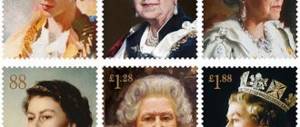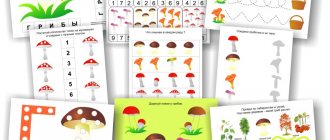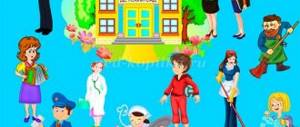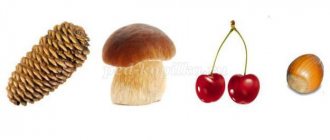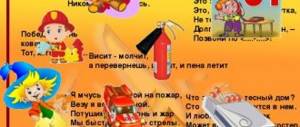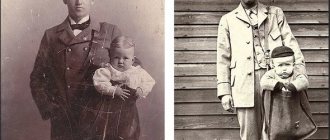Fairy tale game for elementary school children
Interactive game: “Visiting a fairy tale!” Scenario for grades 1-4
The event scenario is for primary school students from grades 1-4; it can also be held in camps of various directions.
Author: Larisa Vasilievna Kalugina, teacher-organizer for primary school, municipal budgetary educational institution “Secondary school with in-depth study of individual subjects No. 28 named after. October Revolution" in the city of Kirov, Kirov region. Goal: To generalize knowledge about fairy tales and cartoons, not only Russian, but also foreign. Objectives: • test children's knowledge about fairy tales, both original and folk, knowledge of the authors of fairy tales; • expand your horizons on various types of fairy tales, both Russian and other peoples; • develop the ability to recognize fairy tales and their heroes; • teach children to work in a team; • develop a sense of camaraderie; • development of aesthetic and moral perception of the world. Purpose: The development of an interactive game is intended for primary school students from grades 1 to 4, both in parallel and in the classroom, but children will need to be divided into teams, camps of various directions, for children's recreation areas; Junior schoolchildren aged 6 - 10 years can take part in the interactive game. Equipment: seats for 4 teams, projector, screen, gifts for teams, certificates in the nominations “Connoisseurs of Cartoons”, “Connoisseurs of Fairy Tales”, “Connoisseurs of Songs”, “Connoisseurs of Cartoons and Fairy Tales of Different Countries”. MUSIC “Visiting a fairy tale.” Host: Hello, dear guys! I am glad to see you at our interactive game called “Visiting a Fairy Tale.” Every person becomes familiar with fairy tales from a very early age. These are the very first works that people begin to read. After all, it is thanks to fairy tales that we become kinder, learn to condemn evil, admire kindness; they contain a lot of educational, interesting, and magical things. And today we will check how you know them. INSERT video: “The Storyteller” (how our fairy tales began: “Once upon a time there was a grandfather and a woman...”)
Host: This is how the storytellers began their fairy tales. Guys, tell me, what kind of fairy tales are there? Absolutely right, they are author's and folk, author's fairy tales have their own author, but folk tales do not have an author, which is why they are called that - folk. I ask the teams to take their places (children come up with a team name in advance). I present to you our jury: - school librarian; - director of the school theater; - art teacher. So, are our teams ready? Then the first round (GONG) is a “warm-up” round, each team receives 1 point for the correct answer. Let's start with 1 command - choose a question. There are 12 numbers on the slide, children select any number, then a question opens via a hyperlink, after the children answer, the answer appears by clicking.
The numbers at the presentation are as follows: Number 1 – question: Name the fairy-tale character who goes out of his way?
Answer: “The Frog Princess” Number 2 – question: What is the name of the aircraft on which a woman first took to the air?
Answer: Broom. Number 3 – question: What is the name of the part of a woman’s dress that contains rivers, lakes, swans and other environmental objects?
Answer: Sleeve. Number 4 – question: What is the most reliable means of orientation in fairy-tale situations?
Answer: Tangle. Number 5 – question: What was the name of the king who was cocked? Answer: King Dadon. Number 6 – question: What is the name of the sewing accessory, which conceals a mortal danger for fabulous centenarians?
Answer: Needle. Number 7 – question: What reward for the feat do fairy-tale kings promise heroes? Answer: Half the Kingdom . Number 8 – question: Which Russian folk tale describes the life of a friendly communal apartment? Answer: Teremok. Number 9 – question: What starting product is needed to cook fabulous porridge? Answer: Axe. Number 10 – question: What is the name of the fabulous individual reusable aircraft? Answer: Stupa. Number 11 – question: What is the name of the “wild but cute ghost”?
Answer: Carlson. Number 12 – question: What is the name of the tavern where Pinocchio dined with the fox Alice and the cat Basilio?
Answer: “Three minnows” 2nd round. (GONG) Presenter: Based on the results of the 1st round, the team __________ (team name) is in the lead. And we are starting our 2nd round “Guess the cartoon”. So, here are 3 types of different types of cartoons - Disney cartoons, Soviet cartoons and 21st century cartoons. We'll start with the second team, choose which cartoons you will guess. At the presentation there is a slide with cartoon characters. 1 picture with a Disney character. And the picture has a question. 2nd picture on the same slide is a picture with a Soviet cartoon hero.
Caption on the picture.
3 picture with a cartoon character of the 21st century. Caption on the picture. The words in the inscriptions have hyperlinks to a picture from the cartoon; when you click on the word, it opens, then when you click on the picture again, the name of the cartoon opens, that is, checking the children’s answer.
1 picture and Disney Disney characters, on the hyperlinks of the picture and by clicking on the name of the cartoon, 6 in total: 1) “DuckTales”
2) "Beauty and the Beast"
3) "Tangled"
4) "Toy Story"
5) "Finding Nemo"
6) “Snow White and the Seven Dwarfs”
2 picture Soviet cartoons, on the hyperlinks of the picture and by clicking the answer, the name of the cartoon, 6 in total: 1) “Bag of apples”
2) "Boniface's Vacation"
3) “The Little Humpbacked Horse”
4) “The Secret of the Third Planet”
5) "Flying ship"
6) “Shake!” Hello!"
3 picture new Cartoons of the 21st century, on the hyperlinks of the picture and by clicking the answer, the name of the cartoon, 6 in total: 1) “Kung Fu Panda”
2) “Treasure Island”
3) "Shrek"
4) “Ilya Muromets and the Nightingale the Robber”
5) “Masha and the Bear”
6) "Ratatouille"
Presenter: And now, based on the results of the 2nd round, we give the floor to our jury. The jury's word. 3 round (GONG) Music from cartoons. There are also 4 pictures with numbers on the slide: Presenter: Attention, we continue and begin the 3rd round “Music from Cartoons”. You are also offered a choice of 4 numbers, behind each number there is an excerpt from the cartoon, after listening to the end of the melody, you must name the cartoon from which it sounded, name the composer of this melody and the author of the text. Please, team 3, choose a number. If you know the song, sing along. 1st number - Music sounds - an excerpt from the cartoon “The Bremen Town Musicians” Answer, inscription on the slide: Song of the ingenious detective from the cartoon “The Bremen Town Musicians” Song of the Ingenious Detective.
music by Gennady Gladkov words by Yuri Entin 2nd figure – music – excerpt from the cartoon “Shake! Hello!" Answer, the inscription on the slide: Song “Clouds” from the cartoon “Shake!” Hello!" words – Sergei Kozlov
music - Vladimir Shainsky
Number 3 – music – an excerpt from the cartoon “Mother for the Baby Mammoth!” Answer, the inscription on the slide: Song “Baby Mammoth” from the cartoon “Mother for the Baby Mammoth!”, lyrics by Dina Nepomnyasha
music - Vladimir Shainsky
Number 4 – music – excerpt from the cartoon “Flying Ship!” Answer, the inscription on the slide: Song of “Vodyanoy” from the cartoon “Flying Ship!”
words – Yuri Entin music – Maxim Dunaevsky
Presenter: I ask the jury to announce the results of the 3rd round and the overall results after three rounds. The jury's word
.
Host: Well, guys, are you tired? Let's take a little rest. Everyone stand up and repeat after me (do it 3 times). Stretch my darling. pulling up, pulling the legs, pulling the little hands. feet rise on toes, Fatigue, go away quickly, strength, come. tension in all muscles, arms bent at the elbows, Smile, little peephole, at least once. a smile is a facial movement. 4th round (GONG) Presenter: Let's continue. Round 4 “Guess the cartoon!” We offer 4 numbers and 4 cartoons. Word 4 to the team, choose a number. By selecting a number, you will be shown an excerpt from the cartoon; after viewing, you must name the name of the cartoon and the author of this fairy tale. Numbers in the form:
1st number – we show an excerpt from the cartoon “The Princess and the Pea” (duration 1.5 – 2 minutes). Answer, and presentation slide: “The Princess and the Pea,” by Hans Christian Andersen 1805 – 1875.
Number 2 – we show an excerpt from the cartoon “The Scarlet Flower” (duration 1.5 – 2 minutes). Answer, and presentation slide: “The Scarlet Flower”, author Sergei Timofeevich Aksakov 1791 – 1859 Number 3 – we show an excerpt from the cartoon “The Little Humpbacked Horse” (duration 1.5 – 2 minutes). Answer, and presentation slide: “The Little Humpbacked Horse”, author Pyotr Pavlovich Ershov 1815 - 1869
Number 4 – we show an excerpt from the cartoon “Straw Barrel” (duration 1.5 – 2 minutes). Answer, and presentation slide: “The Straw Barrel,” a Russian folk tale.
Presenter: The jury's word. 5th round (GONG) Host: And we have the last, final round “Through the Mouth of a Baby.” We were in our sponsored kindergarten and asked the children to tell you 4 fairy tales, but so that they did not name the main characters of the fairy tales. Team 1 also chooses one of the numbers on the screen, and our preschool children will tell you the tale they have planned. After viewing, you must name the fairy tale and the author (fairy tales were chosen at the discretion of the children). 1st number – we show a video of children explaining the fairy tale (duration 1.5 – 2 minutes). The correct answer, on the presentation slide: “Masha and the Bear,” a Russian folk tale. Number 2 – we show a video of children explaining the fairy tale (duration 1.5 – 2 minutes). The correct answer, on the presentation slide: “The Hare and the Fox,” a Russian folk tale.
Number 3 – we show a video of children explaining the fairy tale (duration 1.5 – 2 minutes). The correct answer, on the presentation slide: “The Ryaba Hen,” a Russian folk tale.
Number 4 – we show a video of children explaining the fairy tale (duration 1.5 – 2 minutes). The correct answer, on the presentation slide: “Geese and Swans,” a Russian folk tale.
Host: Well, our game has come to an end. Guys, was it difficult? What was the hardest thing? What did you like? While our jury is summing up the results, I have a question for you: remember how fairy tales end? Children's answers. INSERT VIDEO (the storyteller says: “And they lived happily ever after. The fairy tale is a lie, but there is a hint in it, a lesson for good fellows...”) Word from the jury. Presentation of certificates and gifts to teams. Host: So what do fairy tales teach us? A fairy tale teaches us to be friends, to be faithful and to live honestly. Let the heroes of fairy tales live in a children's mischievous world, Let wizards look into our house more often. See you again! MUSIC “Visiting a fairy tale.”
We recommend watching:
Game - fairy tale quiz for grades 1 - 2 Scenario. KVN based on Pushkin's fairy tales in elementary school Extracurricular event based on fairy tales for 1st grade Script for a holiday based on fairy tales for elementary school children
Similar articles:
Literary game in elementary school based on Andersen's fairy tales
Scenario for a competition program based on Andersen's fairy tales, grade 5
Extracurricular event on fairy tales, grades 1-2
Quiz game based on Andersen's fairy tales for 4th grade
Extracurricular event on the theme “Fairy Tales” for elementary school
Algorithm for conducting an interactive game
- The teacher prepares exercises and tasks for children. It is better to conduct a trial game first, and conduct the final game in the next lesson.
- The children are given the goal of the game, and what result they should get at the end of the game, the teacher gives detailed instructions on what should happen during the game. It is necessary to explain to the children in detail and clearly so that the children understand the whole essence of the game.
- From the beginning to the end of the game, children interact with each other, the teacher monitors the progress of the game and corrects the children, if necessary, helps them, guides them to achieve their goal.
- When the game is over, give the children some rest so they can concentrate and listen to your advice and analysis of the game.
The teacher must discuss with the children the course of the game, difficult moments, what actions the children took during the game and the result of the game.
The most important thing is to make sure that the children do not just play and forget about your game, but that they enjoy the game and interact with each other.
Didactic games
Do not confuse interactive games for classes with didactic ones. In the first, one way or another there is communication and interaction. In the second, the main element is active cognition followed by evaluation. Examples of didactic interactive games include:
- Games with objects. Children need to select objects of the same shape, size, etc.
- Verbal didactic games are usually aimed at improving pronunciation and expanding children's vocabulary.
- Printed board games are played with the help of visual aids. Most often these are paired cards and “Memories”, which train the child’s memory and observation skills.
Board games
Interactive board games have become very popular and are enjoyed by everyone, young and old. This requires a certain perseverance and concentration, so the minimum age of children for such activities is 4-5 years. The modern world of board games offers a wide range of activities that will not only entertain the company, but also help you learn new things or reinforce material. The word "interactive" in the name indicates feedback or interaction of some kind. These board games often respond to children's actions and encourage them to develop dexterity, fine motor skills, and coordination. Here is an example of such benefits:
- The well-known game “Operation”, in which the child needs to carefully remove the disease without affecting healthy organs. Such entertainment not only develops coordination, but also helps to learn the names of human internal organs.
- “Shark Hunt” is a board game that consists of a playing field, chips, four fish and a hungry shark. Players take turns throwing chips. The colored sides on the dice indicate fish of the same color. They need to be moved before a hungry shark eats them. The game does not have a special educational load, but children really like it.
- “Crocodile Dentist” is a fun game in which a sick crocodile needs to click on all the teeth in turn, avoiding the sick one if possible. If you get on it, the crocodile will immediately slam its mouth shut, which will mean loss. The game trains dexterity and coordination.
Types of games
Among the variety of games for preschoolers with an interactive element, the following types can be distinguished:
- Games based on fairy tales are popular in preschool institutions. Such productions are understandable to children, because they feature characters known to them from childhood. Just in case, before playing such a game, you need to conduct a preparatory lesson that will remind the children about the heroes of the story. Leading questions from the teacher will help kids remember the plot and meaning of the fairy tale.
- Games that introduce children to the world around them. For preschoolers, the topics are simpler: “Pets,” “Hard and Soft,” “Who Lives in the Forest,” etc. For schoolchildren, the topics may be more complex: games to develop self-control, which teach group support and help to get to know classmates better, come out on top. Using a poetic form (it is best perceived by ear), the teacher greets the children and explains what the rules will be.
- Games using presentations or an interactive whiteboard successfully complement the lesson and make it more fun and visual. For schoolchildren, the presentation may include collective tasks on literacy or arithmetic, and for younger children - pictures of animals and various quizzes. However, when using a computer, one should not forget about the main goal of an interactive game - to establish communication between children.

